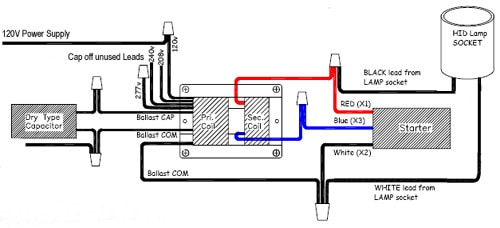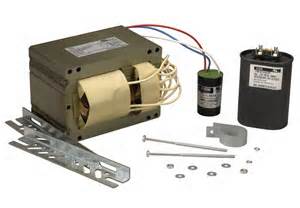1. No Power to metal halide ballast
Check fuses or other causes of power outages.
2. Normal End of Lamp Life
Often the simplest procedure is to test the lamp in an adjacent fixture which is known to be operating properly and then replace as necessary. It should be kept in mind that series metal halide ballast will occasionally extinguish the adjacent lamp if one is removed.
3. Lamp Loose in lamp Socket
Inspect the lamp to see if there is any indication of arcing at center contact button. Tighten lamp to seat it properly. If base is distorted and will not seat properly in the light bulb socket, replace lamp.
4. Optical & Other Sensing Devices Inoperative
Replace sensing device. (Check this by covering sensing device to block out light while power is applied to fixture.)
5. Defective or Improper Wiring
Examine wiring to ensure it conforms with wiring diagram on the ballast label. Check primary wiring to ballast and from ballast to socket to establish circuit continuity. Check connections to see that they are secure. Check for under-sizing of wire gauge, resulting in lowered voltage. Repair circuit.
6. Voltage at Fixture Too Low
Measure line voltage at input of ballast. For most types of metal halide ballast, measured line voltage should be within 10% of label rating. With many types of distribution systems, increased loading or demand decreases available voltage at the ballast primary. Therefore, ideally, a check should be made at full load. If tapped ballast, match ballast tap connection to supply voltage measured at ballast. Increase supply voltage if feasible. Verify that lamp to remote ballast distance is acceptable.
7. Incompatible Ballasting
Correct ballasting is essential for dependable HID lamp operation. Any HID lamp will perform erratically or fail to start on an incorrect ballast. Make sure that the metal halide ballast label data agrees with the line voltage and lamp used. Incorrect ballasting will generally cause a lamp to fail prematurely.
8. Defective Shorted Ballast
A shorted ballast will generally cause the seals at the end of the arc tube to rupture with an indicative blackening in the seal ring area. Shorted condition may be due to shorted capacitors, shorted leads or shorted winding. Replace components as required.
9. Improper Lamp Operating Position (Metal Halide Only)
The operating position should agree with the lamp specifications. A BU-HOR lamp can be operated base up, vertical to, and including the horizontal, and BD can be operated base down, vertical to, approaching, but not including the horizontal. A lamp operated beyond the specified position may not start and degrade lamp performance if it does start.
10. Lamp Has Been Operating : Cool Down Time Insufficient (Hot Restrike)
When HID lamps are operating and the supply voltage is cut or interrupted, the lamps will require a period of time to cool and re-establish optimum starting conditions. Bare mercury and metal halide lamps require from four to eight minutes cool down time. High pressure sodium lamps require approximately one minute to cool before restriking. In a luminaire, restart time varies with the degree of ventilation built into it, ambient temperature, and draft conditions. The time from cool to restartable condition can realistically range up to 20 minutes for mercury and metal halide lamps in tight luminaires.
11. High Restrike Voltage (Metal Halide Only)
This condition is peculiar to the metal halide lamp. It does not occur with mercury. If the supply voltage to a metal halide lamp is interrupted during the warm up period, the subsequent restrike voltage (voltage required to restart the lamp) may be higher than that required for a lamp which has been allowed to stabilize (come up to full output normally) or to cool down to normal room temperature.
12. Improper Ballast for Lamp Operating Conditions Environmental conditions such as extreme temperatures, high humidity and other factors affect ballast operation. Check lamp environmental operating conditions against published performance.
13. End of Ballast Life The appearance or condition of a ballast may give a clue to whether it is good or not. If it is charred, it may have been subjected to sustained excessive heat. Swollen capacitors indicate trouble. Check with appropriate testers, ammeter, and voltmeter. Frequently, the failure mode of a ballast is capacitor failure with consequent low power factor operation and high current. This leads to overheating of the core and coil and eventual failure.

14. Defective Ignitor
Insure that the lamp is good. Disconnect the ignitor and install a specified test lamp. If the test lamp lights, the ballast is good but the ignitor is not. Replace ignitor. If the test lamp does not light, the ballast has most likely reached its end of life.
15. Mismatched Ignitor Verify that the ballast and ignitor are matched according to the specifications. Replace if necessary.
16. Lamp Defects
Common defects that require the lamp to be replaced include:
Suggestions for HID Fixture Maintenance
Proper maintenance of any lighting system is essential to maintain levels of illumination necessary for productivity,
merchandising, visual comfort, safety, and security. If an individual component fails and is allowed to remain in the lighting
system, costly damage to other components can result. Major repairs can often be avoided by simple maintenance
procedures and timely attention to small problems, such as replacing burned-out lamps.
Preventing a problem from occurring is more desirable and economical than fixing it later. A scheduled program of preventive maintenance
can save money while maintaining productivity and safety. By using the following maintenance strategies, the ballast will
have a longer, more trouble-free life. There are many lighting maintenance contractors and electrical contractors who can economically
perform a scheduled maintenance program.
Safety First
Ballast, capacitor and starter replacement, as well as lighting maintenance, presents the possibility of exposure to potentially
hazardous voltages and should be performed only by qualified personnel. All installation, inspection and maintenance should be
performed only with the entire circuit power to the fixture or equipment turned off.
All ballasts, components and fixtures must be installed and operated in compliance with the National Electrical Code, requirements
of Underwriters Laboratories, Inc., and all applicable codes and regulations. This includes, but is not limited to, proper grounding of
ballasts, components and fixtures as well as prescribed branch and total circuit protection.




